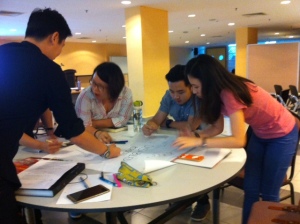Understanding barriers
We did the ‘understanding barriers’ exercise a week ago with the M Arch students and the research assistants. This exercise was introduced to me in 1998 when I participated in a UN ESCAP training course in Penang. Since then I had used this exercise in many other events, notably with the local authorities.
The following is an explanation from ESCAP together with photos from the session.
- To facilitate an orientation towards a common understanding among the participants of the attitudinal and societal barriers that are inherent in everyone, participants engaged in an exercise that required them to spontaneously draw or write their individual impressions and feelings associated with the text given to them: the text on each large sheet of white paper was either “Person” or “Disabled Person”. The participants worked together in groups of six to eight persons to respond in silence to the written text. The purpose of the exercise was to elicit deep-seated feelings and thoughts regarding “Disabled persons”. To highlight this, a contrast was provided through responses to “Persons”.
- Responses to the text differed markedly. Generally, the word “Person” evoked responses that were more positive, life affirming and with future-oriented possibilities. The sheets were populated with lots of “smileys”, with brighter and happier colours used.
- Overall, responses to “Disabled Person” tended towards protection, sympathy, responsibility, care and problems. The colours were more sombre. The expressions pertained to international access symbols, ramps and money/costs. There was a relative lack of warmth, family and home.
- In the analytical processing of the responses, it was underscored to participants that:
- It was the environment, products and services as currently designed that had a disabling impact on persons;
- There were cultural beliefs and myths that caused stigmatization of “the disabled” in many societies of the Asia-Pacific region; however, having an impairment per se should not be a reason for the exclusion of a person from participating in society;
- Disability had no borders and cut across all social and economic strata; disability-ability was a continuum in that everyone experienced different levels of ability at different stages in life, as well as under different circumstances and in different conditions;
- Thus, it would be incorrect to dichotomize all persons into two simple categories: “normal/”healthy-complete” versus “handicapped”/”unhealthy-incomplete” or “we/us” and “they/them”.
Text above taken from:
Report on the ESCAP South-South Cooperation Programme on Accessibility for Persons with Disabilities, 10-19 December 2014 in Guangzhou-Macao-Hong Kong, China




